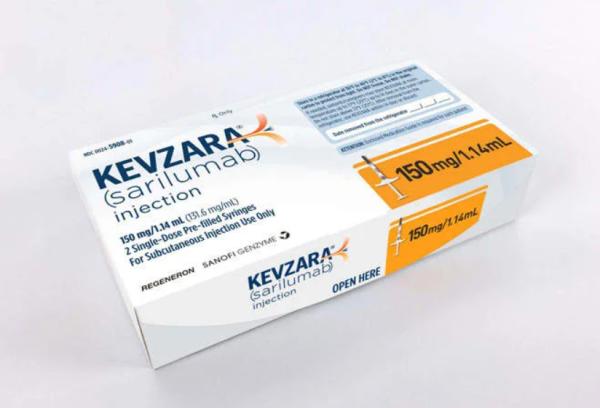Sarilumab Dosage
Medically reviewed by Drugs.com. Last updated on Feb 8, 2024.
Applies to the following strengths: 150 mg/1.14 mL; 200 mg/1.14 mL
Usual Adult Dose for:
Additional dosage information:
Usual Adult Dose for Rheumatoid Arthritis
200 mg subcutaneously every 2 weeks
Comments:
- This drug may be used as monotherapy or in combination with methotrexate (MTX) or other conventional DMARDs.
- Test patients for latent tuberculosis (TB); if positive, consider treating for TB prior to initiating therapy.
- Avoid using this drug with biological DMARDs because of the possibility of increased immunosuppression and increased risk of infection; concurrent use with biological DMARDs such as TNF antagonists, IL-1R antagonists, anti-CD20 monoclonal antibodies and selective co-stimulation modulators has not been studied.
- Avoid use in patients with active infections.
Use: For the treatment of adult patients with moderately to severely active rheumatoid arthritis who have had an inadequate response or intolerance to one or more disease-modifying antirheumatic drugs (DMARDs)
Renal Dose Adjustments
Mild to moderate renal impairment: No adjustment recommended.
Severe renal impairment: Data not available
Liver Dose Adjustments
The safety and efficacy of this drug have not been studied in patients with hepatic impairment, including patients with positive HBV or HCV serology.
Dose Adjustments
- If a patient develops a serious infection, hold therapy until the infection is controlled.
- This drug is not recommended in patients with an absolute neutrophil count (ANC) less than 2000/mm3, platelet count less than 150,000/mm3, or who have ALT or AST above 1.5 times the upper limit of normal (ULN).
Nonhematologic toxicity:
- Hypersensitivity (anaphylaxis or other clinically significant hypersensitivity reaction): Permanently discontinue therapy.
- Infection (serious): Interrupt therapy until the infection is controlled.
DOSE MODIFICATIONS:
- Absolute Neutrophil Count (ANC):
2) ANC 500 to 1000/mm3: Hold therapy until ANC is greater than 1000/mm3 then resume therapy at 150 mg subcutaneously every 2 weeks and increase to 200 mg subcutaneously every 2 weeks as clinically appropriate.
ANC less than 500/mm3: Discontinue therapy.
- Low Platelet Count:
2) Platelets less than 50,000/mm3: Discontinue therapy if confirmed by repeat testing.
- Liver Enzyme Abnormalities:
2) ALT greater than 3 to less than or equal to 5 x ULN: Interrupt therapy; when ALT is less than 3 x ULN, resume therapy at 150 mg subcutaneously every 2 weeks and increase to 200 mg subcutaneously every 2 weeks as clinically appropriate.
3) ALT greater than 5 x ULN: Discontinue therapy.
Precautions
US BOXED WARNINGS:
Risk of Serious Infections:
- This drug is associated with an increased risk for developing serious infections that may lead to hospitalization or death. Opportunistic infections have also been reported. Most patients who developed infections were taking concomitant immunosuppressants such as methotrexate or corticosteroids. Avoid use of this drug in patients with an active infection.
- Reported infections include:
2) Invasive fungal infections, such as candidiasis, and pneumocystis. Patients with invasive fungal infections may present with disseminated, rather than localized, disease.
3) Bacterial, viral, and other infections due to opportunistic pathogens.
- Closely monitor patients for infection during therapy with this drug. If a serious infection develops, interrupt therapy until the infection is controlled.
- Consider the risks and benefits of this drug prior to initiating therapy in patients with chronic or recurrent infection.
Safety and efficacy have not been established in patients younger than 18 years.
Consult WARNINGS section for additional precautions.
Dialysis
Data not available
Other Comments
Administration advice:
- This drug is intended for use under the guidance of a healthcare professional.
- A patient may self-inject or the patient's caregiver may administer this drug after proper training.
- Rotate injection sites with each injection. Do not inject into skin that is tender, damaged, or has bruises or scars.
Storage requirements:
- Refrigerate at 36F to 46F (2C to 8C) in original carton to protect from light. Do not freeze. Do not shake.
Reconstitution/preparation techniques:
- Allow the prefilled syringe to sit at room temperature for 30 minutes prior to injection. Do not warm in any other way.
- Inspect the syringe contents visually for particulate matter and discoloration prior to administration. The solution should be clear and colorless to pale yellow. Do not use if the solution is cloudy, discolored or contains particles, or if any part of the prefilled syringe appears to be damaged.
Frequently asked questions
- What are the new drugs for rheumatoid arthritis (RA)?
- Does Kevzara cause weight gain?
- How long does it take for Kevzara to work?
- How do you use Kevzara (sarilumab) for the treatment of rheumatoid arthritis?
More about sarilumab
- Check interactions
- Compare alternatives
- Reviews (28)
- Side effects
- During pregnancy
- Drug class: antirheumatics
- Breastfeeding
- En español
Patient resources
Other brands
Professional resources
Other brands
Related treatment guides
Further information
Always consult your healthcare provider to ensure the information displayed on this page applies to your personal circumstances.

